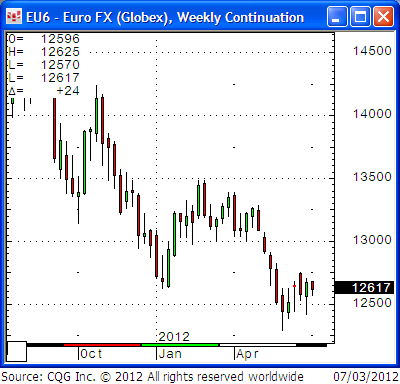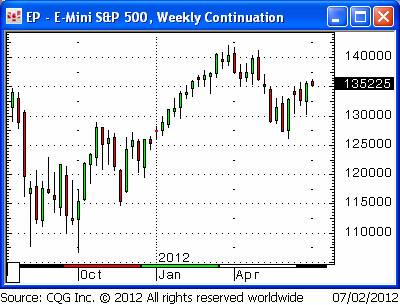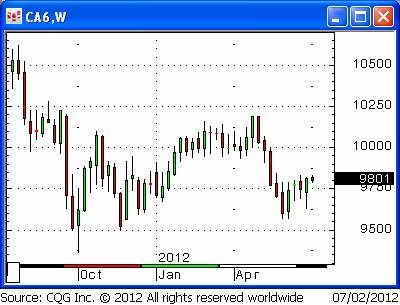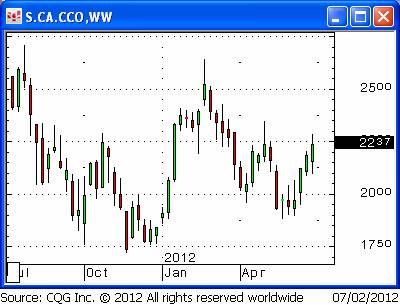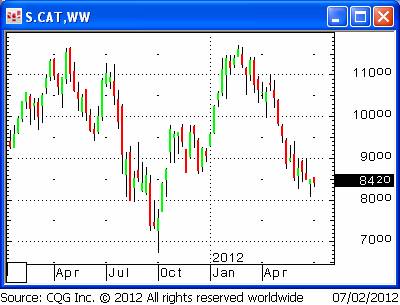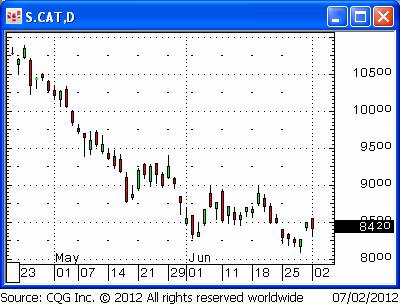As I approach my 29th year in and around Wall Street, I find myself deeply immersed in the worst bear market of my entire career. In a business where failure is the norm, I went against my own multi-decade advice and “sent it in” on junior resource stocks. The results up until now are that I find myself down more on paper than I ever even imagined I could be worth. Given this and the fact that my main livelihood is generated from the junior resource industry, one may want to think twice (or even more) before even considering what I have to say. (I suspect my wife feels that way at the moment.)
The Good – Most of the good is found among the metals themselves and in particular gold and silver. What can only be described as the “stealth bull market of the 21st century” because despite returns well ahead of most other asset classes most Americans still have little or no real exposure to them, gold and silver still have very strong fundamentals long-term.
The “mother” of all bull markets continues thanks to four key reasons:
- Once dominant sellers that capped any advances, Central Banks are now net buyers.
- Gold producers, who once “cut their noses to spite their faces” by selling forward large quantities of future production and helped capped the price by doing so, now operate under the belief hedging is a “four-letter” word among investors.
- Gold Exchange Traded Funds (ETFs) greatly changed the balance between supply and demand. Investors who never or rarely sought exposure to gold beforehand (because of difficulties associated with physical bullion buying) and/or who ended using mining shares for exposure only to see them not come close to correlating movements in the gold price themselves, embraced ETFs in a big and powerful way in order to have exposure to gold. Whether or not those ETFs are really direct ways to physical ownership doesn’t concern them, but their large-scale appetite for them combined with the changes among Central Banks and gold producers greatly altered the supply versus demand in favor of demand.
- Gold is money. There’s no Central Bank printing it like it’s going out of style. There’s no government(s) borrowed up to their eyeballs in it. Where you find real growing wealth in the world you find those people acquiring it are using gold as a storer of their wealth.

Not much good in the mining and exploration side of things so far in 2012 – especially as you move further down the food chain. Unlike other junior resource bear markets, this one doesn’t have easily identifiable reasons for it (but shall once hindsight fully kicks in). The good news is:
- Much of what’s eventually becomes a mine is first found by a junior resource company.
- The world is growing in population and the need for resources should grow with it
- Hard to imagine anything more out of favor at the moment so from a contrarian standpoint, juniors should be appealing.
The Bad– Gold is, and always shall be, hated by most in the financial service industry and the media that makes a living following them. Because of this, perma-gold bears are far more fashionable and get much of whatever ink is thrown gold’s way. Their opposition is mostly relegated to being called kooks, tin-foil hat wearers, gold bugs and worshippers of a relic.
Despite general metals prices much, much higher than a decade or two ago, the mining and exploration industry is far more challenged now than ever before. This is especially true as you move further down the food chain in the junior resource sector. Among the numerous reasons for plight in the junior sector are:
- The audience for mining and especially exploration shares has shrunk despite the dramatic increases in metals prices themselves. A clear example of that is the dramatic drop in the primary “end users” that used to be a key part of the demand side – brokers.
- Years back, hundreds if not thousands of brokers built part or much of their book of business around the buying and selling of mining and exploration stocks. They each had 100 or even 500 clients and many of them ended up buyers of these shares. Unfortunately, these folks are now asset gathers and commission-driven buying and selling is ancient history. They no longer are active in the mining and exploration sector. This is also unfolding in the Canadian financial industry.
- While the 43-101 rule truly reformed what used to be like the Wild, Wild West in the junior sector, it also removed any sizzle from the promotional side of things. While not a bad thing when one recalls what used to go on in this area, the downside to it is companies who are mostly sizzle and not yet steak can’t even light a match when speaking of their potential, let alone stroke the fire. That may be a good thing, too, but it wasn’t the case when these shares did much better as a group a decade or more ago (and a reason one must consider now whether they like it or not).
- Regulatory and/or compliance factors have made it much tougher for juniors to attract attention. Again, this may or may not be a good thing, but it’s a fact of life as far as I’m concerned. In the States, most brokerage firms no longer allow solicitation of companies not trading on the NYSE or major NASDAQ markets. Some don’t even allow unsolicited orders anymore. Many compliance departments have made it difficult or impossible for their advisers to buy juniors-period.
- Canadian investors may be surprised to find most Americans don’t find natural resources as “second nature” to them. Americans’ biggest concerns about natural resources are availability of gas to drive their cars and oil to heat their homes. They’re not keen on natural resource stocks and still think for the most part a gold mine is a hole in the ground with a liar standing next to it.
- The junior sector is a “pimple” of an industry, yet 1,000 to 1,500 juniors are trying to find a few dozen so-called experts who can appreciate and talk about them in a mostlywhat’s-in-it-for-me mindset. The ability to get their story known is perhaps the biggest challenge and drag for a junior these days.
- Reducing the hold period on private placements to just four months has hampered the juniors. Companies just can’t advance themselves up the corporate ladder in such short periods to warrant enough new interest to gobble up all these new free-trading shares that come to market.
- Investment bankers now play the “warrant” game in order to keep deal flow going. They turn to their institutional buyer and suggest selling the shares that are coming free trading for either side of breakeven and hold the warrant as their leverage. Meanwhile, they take the freed up capital and buy their next deal.
- Discount brokerage has also greatly added to what seems like an endless supply of shares. Years back, one held juniors at times simply because they couldn’t profit from selling them after just a few cents rise. Now, thanks to deep discount commissions, one can profit from the sale even if the share price is barely up.
I’m certain there are other reasons, but I believe the above is a good part of why we’re where we are today. The question now is does this mean the mining and exploration stocks are no longer worthy?
The Ugly – Ugliness appears confined to the equity side of things and far more within the junior sector versus major producers.
I’ve seen a report that showed of the 2,388 companies listed on the TSX Venture Exchange, 1,239 have less than 10% of their market value in cash. That means 52% of the Venture needs cash and will have to raise money. With many of these shares down 50%-90% in price, financings shall be highly dilutive if even able to do so. And trust me; the financiers holdall the cards!
The TSX Venture has been the worst performing stock exchange in North America for more than a year now. This decline is the second worst in its history percentage-wise. It’s hard to pinpoint any main reasons as commodity prices in general are still fairly strong, general equity markets have been volatile but net-net are still around levels from a year ago, so I think it has more to do with the reality of several points I noted in the bad section.
Bottomline – The “mother” of all bull markets continues in gold. Two consecutive closes above $1,650 should confirm this and only a break below $1,500 can call such a belief into serious question.
A friend sent me this by an unknown author:
History of Major TSX Venture Corrections And What Followed
(I define a major correction as a 20% decline or more in the overall TSX Venture Index)
The TSX Venture officially formed in 2001. Its starting value was 1,000.
The TSX Venture’s first major correction began on June 4, 2002 after it hit 1,244 (at that date it was a new all-time high). By October 30, 2002, it had bottomed out at 899.30 (losing 27% of its value). This marked a nearly 5-month-long correction (downtrend). After bottoming out on October 30, 2002, the TSX Venture went on a 16-month rally and peaked out on February 17, 2004 at 1,931.61. This marked a 114% rally from bottom to top over that 16-month period.
The next significant correction occurred from February 17, 2004 through to July 27, 2004. This was when the exchanged collapsed from 1,931.61 to 1,467.59 – a modest correction in comparison to what we are seeing today. Over that 5.5-month-period, the TSX Venture lost 24% of its value. However, once it bottomed out on July 27, 2004, it proceeded to go on an 8-month rally and touched 2,040.29 on March 7, 2005. This marked a 39% gain for the TSX Venture in that 8 month period.
The next significant correction was short-lived. The TSX Venture Exchange dropped from 2,040.29 on March 7, 2005 and bottomed out on May 17, 2005 at 1,593.63. This marked a 2-month decline of 22%. It was quite a vicious decline considering how quickly it happened. However, once the correction bottomed out, the TSX Venture went on a monster rally. After bottoming on May 17, 2005 at 1,593.63, the TSX Venture went on a 12-month rally to 3,292.49 (hit May 11, 2006). This marked a gain of 106% in a year.
Following that massive rally, the TSX Venture collapsed from 3,292.49 on May 11, 2006, to 2,322.48 on October 4, 2006. This marked a 5-month decline of 29.5%. However, following that correction, the TSX Venture rallied to all-time highs. It hit 3,369.79 on May 7, 2007. This marked a 7-month gain of 45%.
The next significant correction, after the TSX Venture hit an all-time high, was short and vicious. The TSX Venture went from 3,369.79 on May 7, 2007 to 2,445.23 on August 16, 2007. This marked a 3-month decline of 27.5%. However, following that correction, the TSX Venture rallied to 3,173.64 on November 6, 2007. This marked a 3-month gain of 29.5%.
The next significant correction was the worst any of us have ever seen, but it set up a golden rally for those that stayed at the table and kept buying. After hitting 3,173.64 on November 6, 2007, the TSX Venture went on a 13-month decline and bottomed out at 686 on December 9, 2008. This marked a 78.3% decline over a 13-month period. Great companies with world-class assets were deemed worthless by the market. What a mistake that turned out to be for those selling anywhere near the lows. After the TSX Venture bottomed out, it went on a 27-month rally and hit 2,439.83 on March 4, 2011. This marked a 255% gain in just over 2 years – the greatest rally for any of the major markets in North America during that time period.
The next significant correction for the TSX Venture is the one we currently find ourselves in. Although there was a short-lived rally at the start of 2012, the downtrend in the TSX Venture has been steady since March 4th of last year. Since hitting 2,439.83 on March 4, 2011, the TSX Venture has collapsed down to as low as 1333 on October 4, 2011 (it has been bumping along the bottom ever since). That marks a 45.5% decline from its March 4, 2011 value. That also marks the 2nd largest drop in the history of this exchange. Now, given that we have been bumping along near the bottom of this collapse for 7 months, one can argue that ‘this time is different’. However, every time a market crash occurs, that argument is brought to the forefront.
Those are the statistics behind the 7 crashes the TSX Venture has experienced in its 11 year existence. Crashes and rallies are a part of its genetic make-up. Let’s look at the TSX Venture’s historical averages:
- Average loss (in percentage terms) during a correction (peak-to-trough): -36.25%
- Average duration of a bear market in the TSX Venture: 5:78 months
- Average gain after a correction (trough-to-peak): 98.08%
- Average duration of a bull market in TSX Venture: 11.83 months
I suspect at best we shall see an “L” shape recovery for the remainder of 2012 as heavy tax-loss selling is likely to hit as early as late summer (and any significant rallies shall be deemed by many as a chance to end or lessen the pain). The only hope of a big sustainable rally would be on a strong rise in gold towards $2,000 an ounce.
Adam Hamilton noted recently,
“….While gold’s secular bull propelled it 638% higher at best between 2001 and 2011, the flagship HUI gold-stock index blasted an astounding 1664% higher at best by last September. This performance is epic, as over the same secular span the benchmark S&P 500 actually fell 14%. The gold stocks have leveraged gold by 2.6x so far.
With gold stocks exploding nearly 18x higher during a secular bear where the stock markets were flat, they should be the most popular sector on the planet today. But their recent serious correction of 41% over eight months as measured by the HUI has totally obliterated bullish sentiment. The bears have tried to rationalize these losses as the new normal (as opposed to a temporary selloff) by attacking earnings.
They claim gold stocks are doomed to drift even lower indefinitely because the rising costs of gold mining are rapidly eroding profits. And the lower the earnings gold stocks as a sector can generate, the lower their stock prices should be as investors refuse to overpay for future profits streams…”
The mining industry is indeed challenged on several fronts, including:
- Political and environmental hurdles much higher than a decade or more ago
- Operational costs
- Shortage of skilled labor
Despite this, producers are very compelling going forward.
In October of 2003, the TSX Venture Exchange traded at the same level it does today. What’s important to note about October 2003 is that gold traded for roughly $380 an ounce – it trades 425% higher today. In October of 2003, silver traded for about $5 an ounce – it trades 600% higher today. In October of 2003, a barrel of oil traded for $30 – it trades 320% higher today. In October 2003, Comex copper traded for $0.92 – it currently trades 415% higher.

The TSX Venture has always been a boom/bust exchange. It’s extremely volatile. The exchange has existed for 11 years and during that time; it has gone through 7 bear markets of its own (market downturns of 20% or more). While the bust cycle can still linger, history suggests we’re on either side of a bottom. Assuming all sharp objects have been removed and the wife and kids have not left by now, junior resource players may want to “gamble” on history repeating itself one more time and look forward to celebrating the arrival of 2013.
Gold meanwhile, shall once again slap the overwhelming number of perma-bears in the face again on its way to a new, all-time high.









